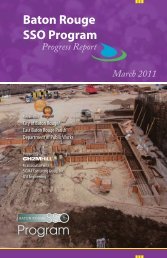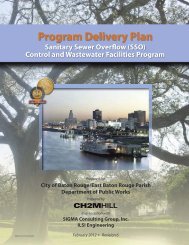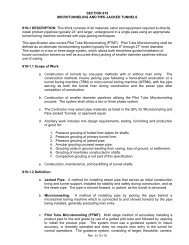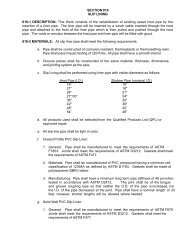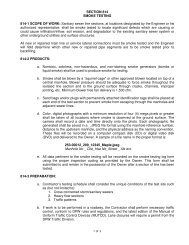Contents
Construction Management Plan - Baton Rouge Department of Public ...
Construction Management Plan - Baton Rouge Department of Public ...
- No tags were found...
You also want an ePaper? Increase the reach of your titles
YUMPU automatically turns print PDFs into web optimized ePapers that Google loves.
2.2.6 Confined Space Entry<br />
(Reference CH2M HILL SOP HSE&Q-203, Confined Space Entry)<br />
The following requirements must be met prior to confined space entry:<br />
• Confined space entrants, attendants, and entry supervisors must complete the CH2M HILL 8-<br />
Hour Confined Space Entry training.<br />
• A Confined Space Entry Permit (CSEP), Alternative Procedure Certificate (APC), or Nonpermit<br />
Certificate (NPC) must be completed and posted near the space entrance point for<br />
review. These forms/permits have been included in Attachment 5;<br />
• Each confined space entrant and attendant must attend a pre-entry briefing conducted by the<br />
entry supervisor;<br />
• Each confined space entrant and attendant must verify that the entry supervisor has authorized<br />
entry and that all permit or certificate requirements have been satisfied;<br />
• Only individuals listed on the Authorization/Accountability Log are permitted to enter the<br />
space;<br />
• Each confined space entrant and attendant must verify that atmospheric monitoring has been<br />
conducted at the frequency specified on the permit or certificate and that monitoring results are<br />
documented and within acceptable safe levels.<br />
The following requirements must be met during confined space entry:<br />
• Communication must be maintained between the attendant and entrants to enable the<br />
attendant to monitor entrant status;<br />
• Entrants must use equipment specified on the permit or certificate accordingly;<br />
• All permit or certificate requirements must be followed;<br />
• Entrants must evacuate the space upon orders of the attendant or entry supervisor, when an<br />
alarm is sounded, or when a prohibited condition or dangerous situation is recognized;<br />
• Entrants and attendants must inform the entry supervisor of any hazards confronted or created<br />
in the space or any problems encountered during entry.<br />
2.2.7 Cranes<br />
(Reference CH2M HILL SOP HSE-303, Cranes, Hoists, and Rigging)<br />
• Only certified crane operators are permitted to operate cranes.<br />
• Maintain safe distance from operating cranes and stay alert of crane movement. Avoid<br />
positioning between fixed objects and operating cranes and crane pinch points, remain outside<br />
of the crane swing and turning radius. Never turn your back on operating cranes.<br />
• Approach cranes only after receiving the operator’s attention. The operator shall acknowledge<br />
your presence and stop movement of the crane. Never approach operating cranes from the side<br />
or rear where the operator’s vision is compromised.<br />
• When required to work in proximity to operating cranes, wear high-visibility vests to increase<br />
visibility to operators. For work performed after daylight hours, vests shall be made of<br />
reflective material or include a reflective stripe or panel.<br />
• Stay as clear as possible of all hoisting operations. Loads shall not be hoisted overhead of<br />
personnel.<br />
GNV310133632156.DOC/090840008 A-15



